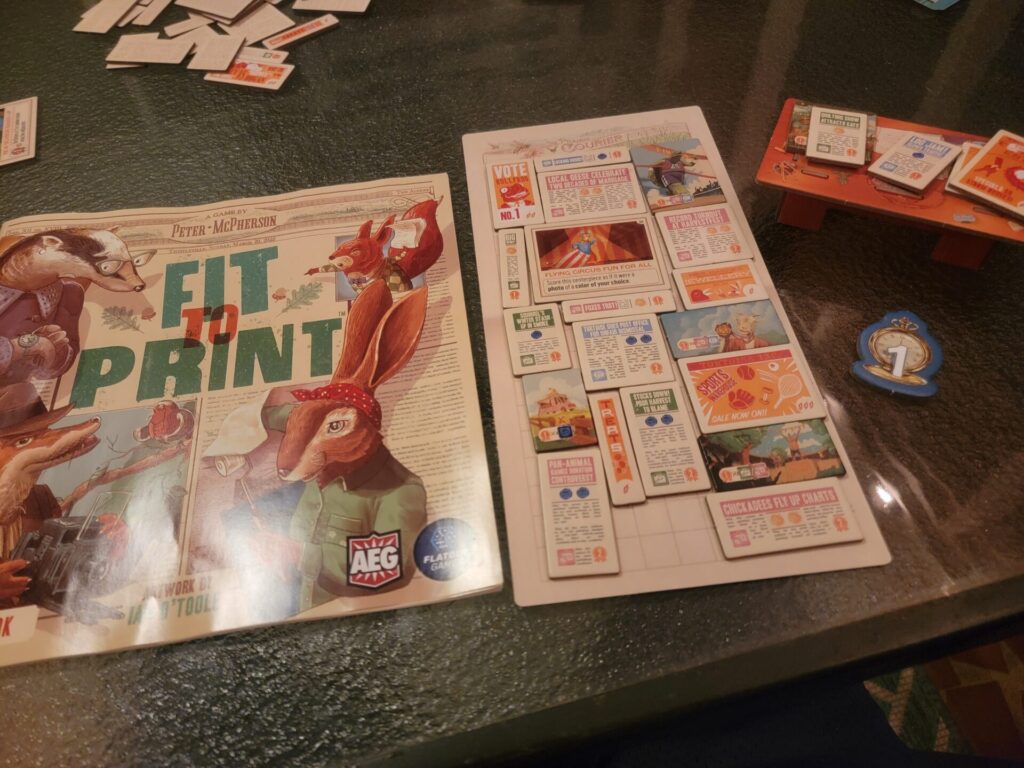
Name: Fit to Print
Year of Release: 2023
Player Count: 1 – 6
Playing Time: 15 – 30 Minutes
Designer: Peter McPherson
Publisher: Flatout Games
Primary Mechanisms: Real-Time, Closed Drafting, Grid Coverage, Tile Placement, Set Collection
Weight (According to BGG.com): 2.07
Overview
Browsing the list of games that have “real-time” tagged as a mechanism on BoardGameGeek, I can confidently say that I’ve played absolutely none of them. Two of the highest rated games (Captain Sonar and Galaxy Trucker), I’ve read plenty about but have never been in a position to play them. Another real-time game I’ve heard about is Pendulum, from Stonemaier Games. I typically like everything Stonemaier puts out, but I’ve never read anything good about Pendulum and a lot of the hate seems to be centered around the real-time aspect. Needless to say, this mechanism wasn’t something I’ve been looking for in a game, that is until I saw the Kickstarter for Fit to Print.
Now, I don’t want it to sound like I rushed to back this because of the real-time angle. I rushed to back it because it was from Flatout Games and I’ve had a blast with their previous two releases, Cascadia and Verdant. But seeing that a publisher I really adored was putting out a game with a mechanic that I had no previous experience with was titillating. Add to that, the wonderful artwork by Ian O’Toole and I was sold.
So, read on to see if Fit to Print fits the bill.
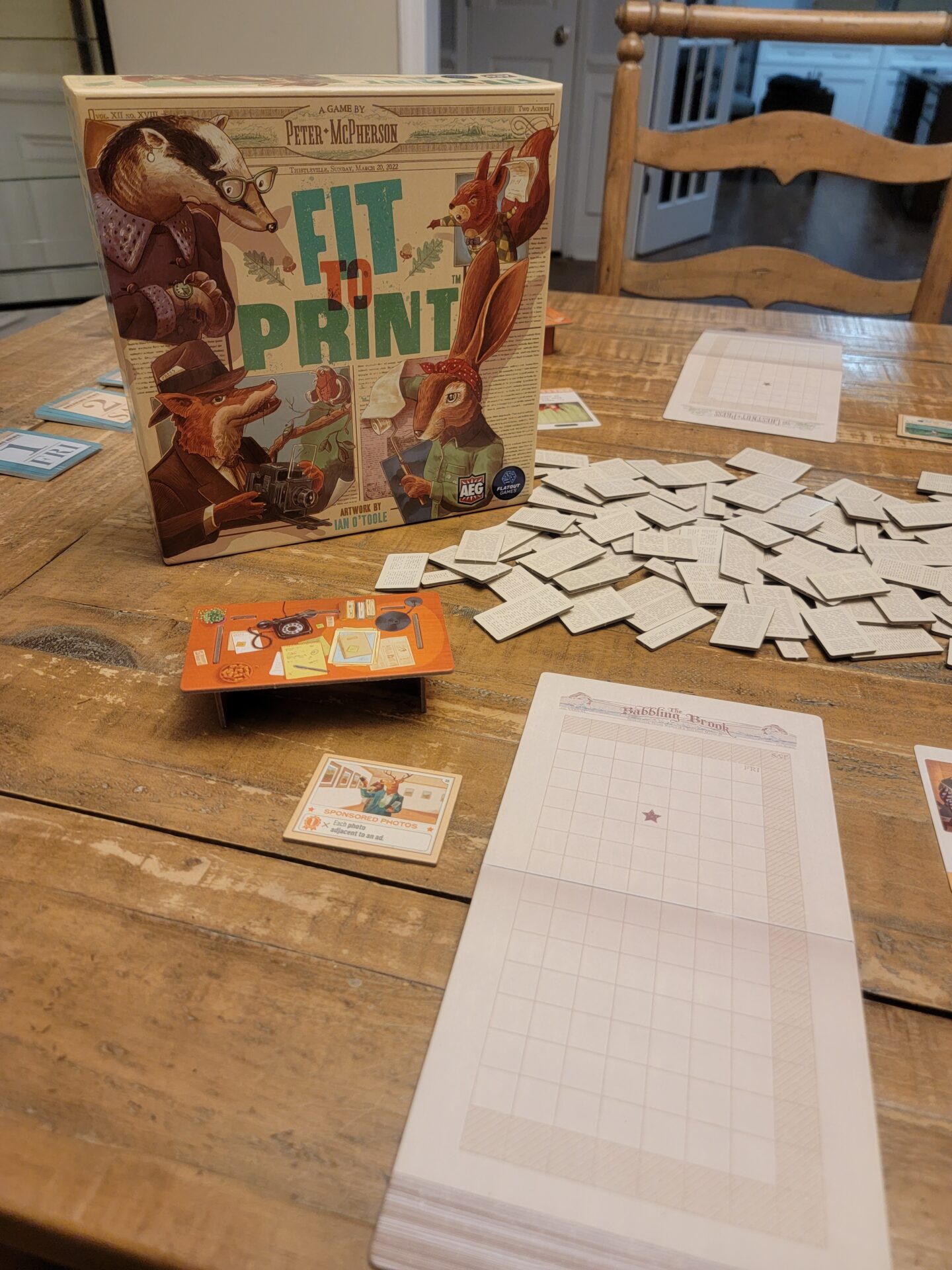
Rulebook & Components
I don’t know if all Flatout Games have the same writer and/or editor for their rulebooks but I can attest that every single one I’ve seen has been done really well. They consistently lay out the setup and rules in a painstaking manner, getting gamers right into the action of playing the game. And like their two previous games I mentioned in the introduction, Fit to Print comes with a set of Achievements printed towards the back of the rulebook that greatly enhances the replay value of the game. Basically, what I’m saying is that I have no qualms with the rulebook.
Moving onto the components, I want to talk about the 120 Newspaper Tiles. These tiles are going to act as the main gaming component, and they are simply lovely to look at. The tiles are split into three types, Articles, Photos, and Ads. Every single one of them is a unique tile, with each Article having a different headline and the Ads being wonderfully created. The tiles themselves really sell the theme of putting together a newspaper in a charming animal-inhabited village. The Newspaper Tiles won’t be the only thing being placed into the newspaper, but players will also get to use different Centerpiece Tiles throughout the game. These are larger tiles that act as a, you guessed it, centerpiece to the newspaper and give players an additional goal each round to score extra points. Again, these tiles have unique artwork, and they are even double-sided, displaying different requirements on each side.
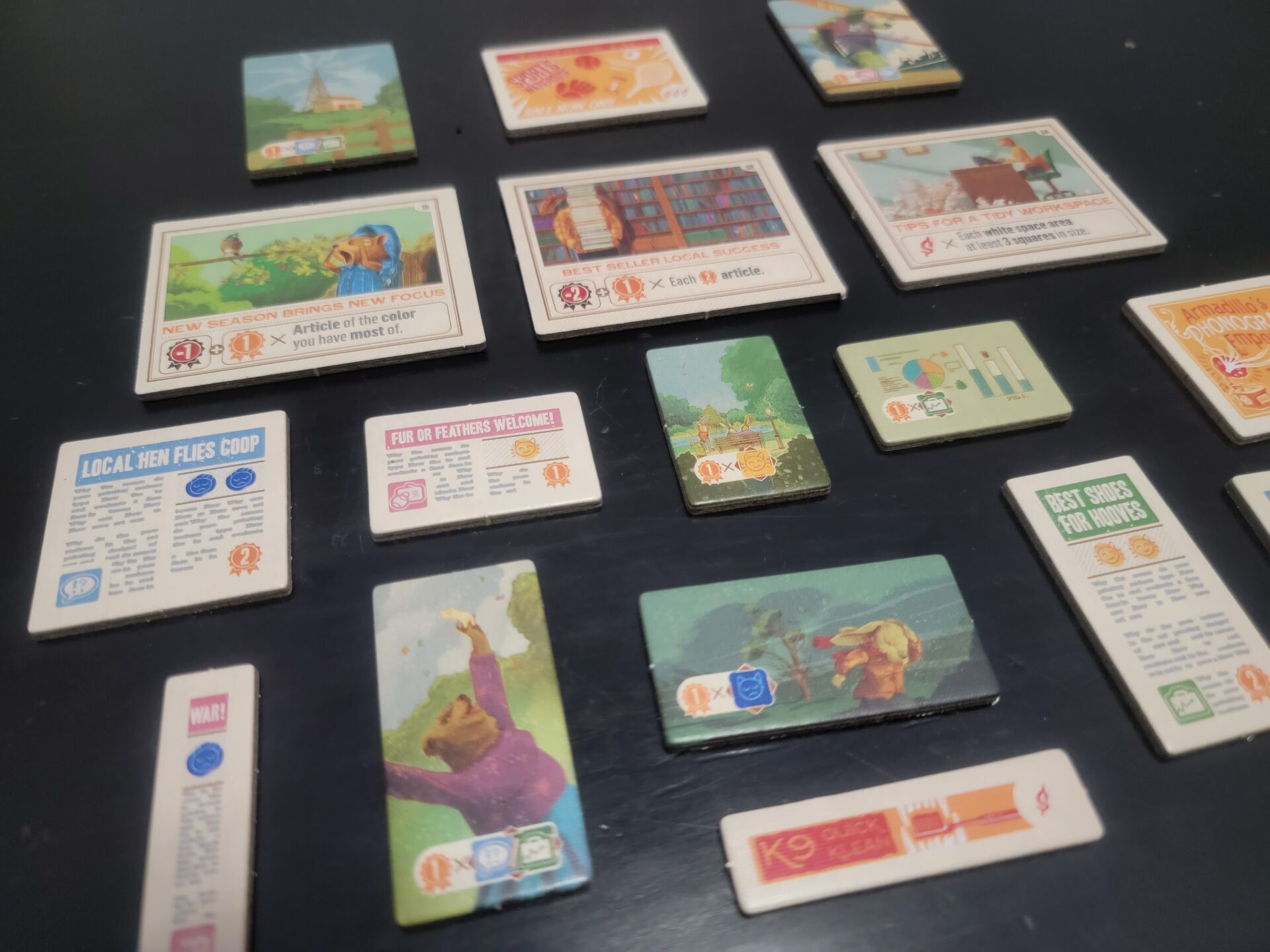
All of these tiles have to be placed somewhere, right? The first place they’ll go is onto each player’s Desk. The desks are actually put together to sit upright on the table and display different artwork on each desk, representing the workspace of one of the six Characters. After the tiles move from the desk (and don’t worry, I’ll explain this in more detail in the Gameplay section below), they come to reside on your actual Paper Board. The six boards each represent a different newspaper and are double-sided, with one side acting as the Friday and Saturday editions of the paper and the back side acting as the Sunday edition.
Lastly, the game ships with a set of Breaking News Cards, split into three types to match the three days you’ll be printing the paper. These cards give all players a goal or a restriction for that round, helping to add different wrinkles to each round. This can be an optional part of the game, especially if you’re playing with new or younger players, but seasoned players will definitely want to mix these into play, as they can make some interesting decisions. I typically talk about Setup next but as there isn’t a ton of it, I’m going to skip that in this write up. But if you are interested more in what the Setup entails, check out both our short “Burst!” video and our more detailed overview video.
Gameplay
Fit to Print is going to be played over three rounds, each representing one of the days that the newspaper is released. The first decision that will need to be made is how long each round is going to be. The game doesn’t ship with any sort of timer, and instead it recommends you use a phone timer. The rulebook suggests rounds be five minutes, four minutes, or three minutes, with players shortening the time for a harder difficulty. But the designers also explicitly say that if players aren’t fans of timed games, feel free to play with no timer at all. Every time I’ve talked about Fit to Print, I’ve tried to make this clear because I don’t want anyone to skip over this game solely because of the timer!
Once the timer has been set, the first round can begin. I mentioned in the introduction that this game is real-time, so all of the gameplay takes place simultaneously for each player. When the round begins, players race to grab tiles from the large deposit in the middle of the table, thus beginning the Research Phase. These tiles are face-down so players don’t know what they are picking up until they get it back to their desks. Once there, the player needs to decide to either a.) keep the tile, placing it on their desk or b.) put it back in the middle of the table but this time face-up so others can see it. Players continue to grab tiles until they feel they have enough to put into their paper and at this time they yell, “Layout!” so that everyone else knows they are moving on to the Layout Phase.
During this Layout Phase, the player is trying to take the tiles from their desk and place them into the grid on their Paper Board, with the goal of scoring the most points. Some points are going to be derived by the color of the tiles. For example, a Photo Tile with a blue or pink symbol in the corner is going to score you points if it is adjacent to a blue or pink Article Tile but will score 0 points if adjacent only to a green tile. Other points are printed straight on the Article Tiles and will award the player with that amount simply for placing them on the newspaper board. Even more points can be gained by meeting special criteria printed on your specific Centerpiece Tile or the current round’s Breaking New card. Lastly, Ads help generate Revenue, instead of Victory Points, because how is a paper supposed to continue to live without those sweet, sweet dollars pouring in?
The rub with the Layout Phase is there are certain rules that have to be followed when placing the tiles. If, at round end, players find someone to have not followed the restrictions, that player must flip the offending tiles, thus forfeiting the possible Victory Points. Some of the rules include no two Articles of the same color can be touching and all tiles have to stay within the printed confines of that day’s grid. There are other considerations, but I’ll let you find those out on your own.
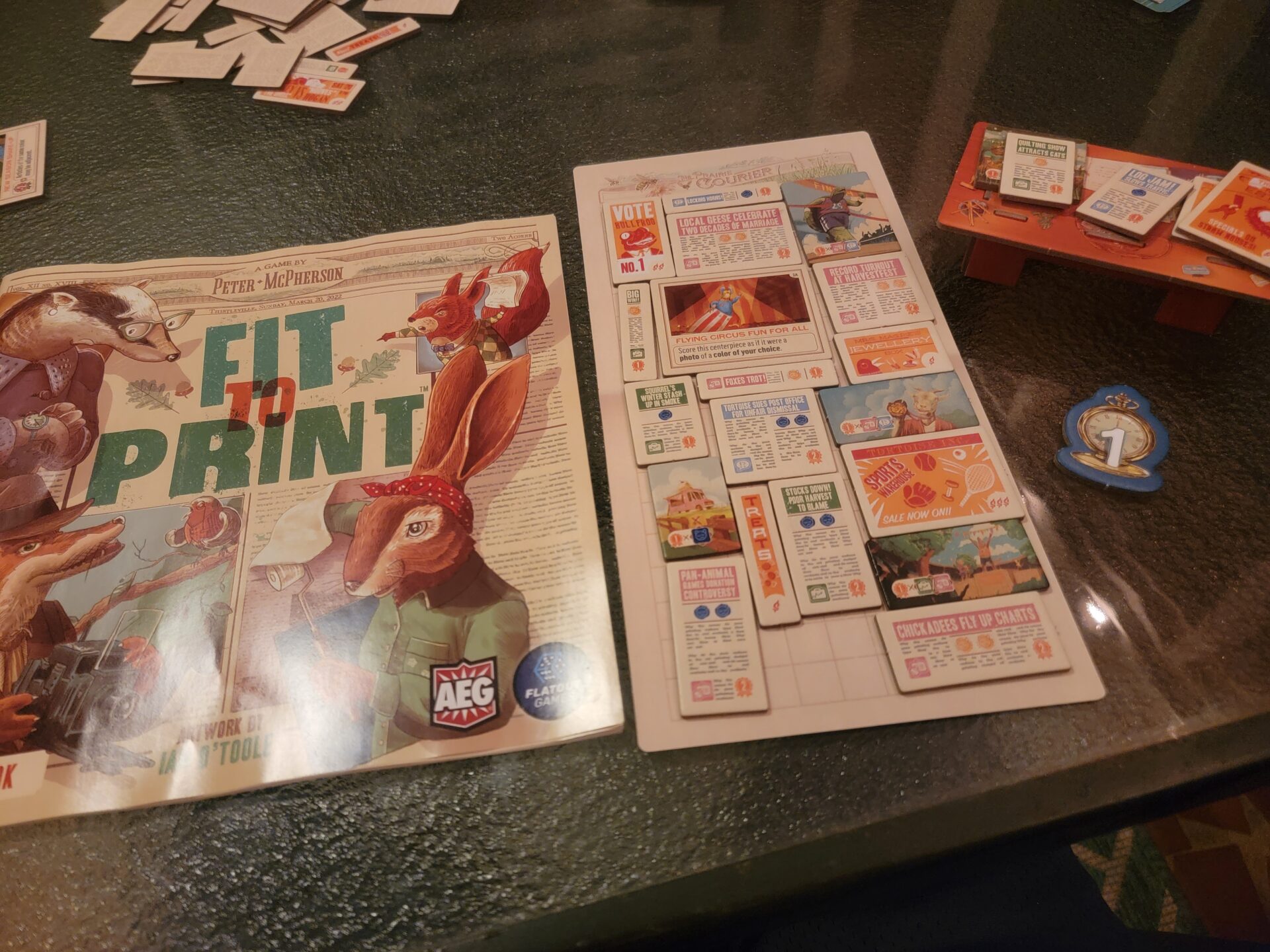
Once a player is satisfied with the layout, they’ll yell, “Print!” and grabs for a Finishing Token. The faster a player goes to print, the earlier they’ll get to choose a Centerpiece Tile in the next round. Oh, and all of this (both the Research Phase and the Layout Phase) has to take place in the original time decided on for the round. In my plays so far, we’ve really enjoyed the four-minute mark. Five seems to be a little too long in that there isn’t a ton of urgency, but three minutes can be a little stressful for those with analysis paralysis.
When all players have gone to print, the round is over, and Victory Points are scored. Points rack up based on some of the criteria I mentioned earlier, but players can also get negative points for the tiles picked up during the Research Phase that weren’t played during the Layout Phase. This helps to make sure that players don’t just hoard tiles with no intention of using them. Players also want to keep their white space (where tiles weren’t placed) to a minimum as well as keeping track of the mood of the paper, symbolized by both smiley and frowny faces that are printed on the tiles. A successful paper makes sure to balance these, never letting the positive or negative outweigh the other too much. Play continues in this way for both Saturday and Sunday and then the winner is decided by total Victory Points accumulated across the weekend.
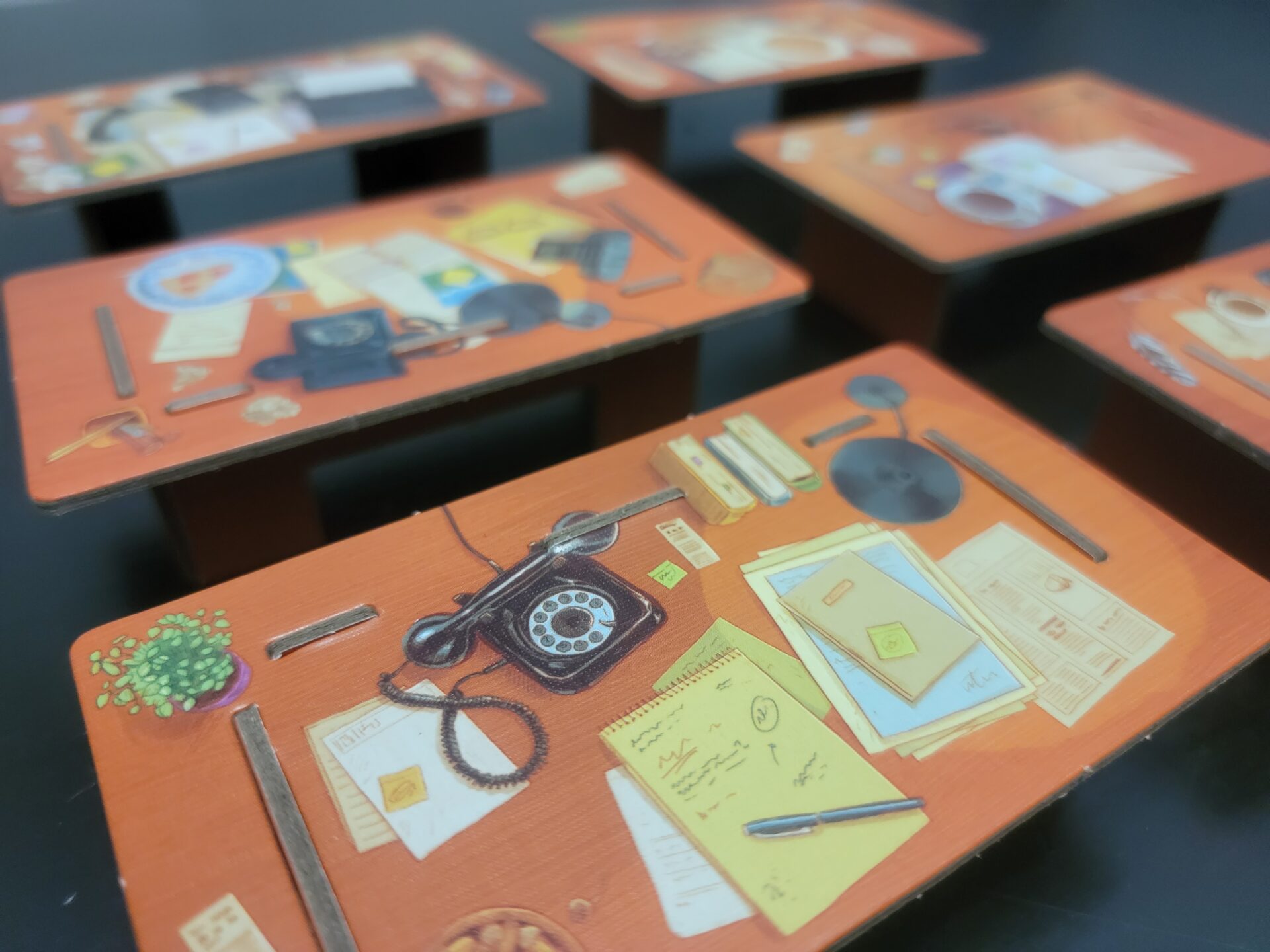
Conclusion
For my first time with a real-time game, Fit to Print has been a massive win in my book. Its timed rounds are flexible enough to accommodate a multitude of gamers, and the real-time angle allows for almost no downtime, so players are always having fun. Add in the whimsical artwork, and a bustling solo variation, and you’ve got a real winner on your hand. If you are looking for a spatial game that brings something slightly different to the table, look no further than Fit to Print.
Rating
Ratings are based on 5 main criteria: rulebook, setup, components, art & graphic design, and gameplay. The first 4 criteria are rated 1 to 5 and the gameplay is rated 1 to 10. These scores culminate in an “overall satisfaction” score that is rated from 1 to 10. If the reviewed game has both a solo and multiplayer mode, I have assigned scores separately to give context to which mode we enjoy more.
Links
As an Amazon Associate I earn from qualifying purchases.
